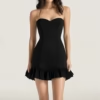Transitioning from a Direct-to-Consumer (DTC) model to wholesale can be a strategic move for fashion brands looking to expand their reach and tap into new revenue streams. Understanding the latest trends, challenges, and strategies is crucial for a seamless transition. This guide outlines ten easy steps for moving your brand from DTC to wholesale, integrating insights into the latest digital wholesale platforms, pricing strategies, and successful case studies of DTC brands that have made this change.
1. Define Your Growth Strategy
Begin by clearly outlining your growth strategy. Identify your target market, set achievable sales goals, and consider how wholesale aligns with your brand objectives. Understanding your market will help tailor your wholesale approach to meet demand effectively.
Key Questions to Ask:
- Who is your target retailer?
- What are your sales and revenue goals?
- How does wholesale fit into your long-term vision?
2. Develop Your Wholesale Product Offering
Craft a product line tailored to the wholesale market. This involves creating exclusive collections, adapting packaging, and ensuring your offerings meet the unique needs of retailers. You avoid direct competition and appeal to a broader audience by differentiating your wholesale products from your DTC goods.
Tips for Product Development:
- Offer exclusive wholesale-only collections.
- Adapt packaging for bulk orders.
- Ensure products align with retailer demands.
3. Build Your Wholesale Infrastructure
Invest in a robust digital wholesale platform. Platforms like Stylebuy can streamline the ordering process, efficiently managing large orders. These platforms offer features such as sales management, inventory control, and integration with other business systems.
Benefits of Digital Wholesale Platforms:
| Feature |
Benefit |
| Order Management |
Streamline bulk orders and reduce errors. |
| Inventory Control |
Track stock levels in real-time. |
| Sales Analytics |
Gain insights into sales trends and retailer preferences. |
| Integration Capabilities |
Sync with existing ERP or CRM systems. |
4. Identify and Connect with Target Partners
Identify retailers that align with your brand values and market positioning. Building a network of reliable retail partners is essential for a successful transition. Attend trade shows, leverage industry contacts, and use digital platforms to connect with potential partners.
Strategies for Building Retailer Relationships:
- Attend industry trade shows like MAGIC or Première Vision.
- Use platforms like Stylebuy to connect with retailers.
- Leverage your existing network for introductions.
5. Market Your Brand to Retailers
Develop comprehensive marketing strategies tailored to retailers. Highlight your brand’s unique value proposition, provide compelling product information, and offer incentives for initial orders. Building a strong brand presence in the wholesale market is crucial for gaining retailer trust.
Marketing Tactics:
- Create a wholesale lookbook or catalog.
- Offer introductory discounts for first-time orders.
- Highlight your brand story and unique selling points.
6. Implement Competitive Pricing Strategies
Pricing in wholesale differs from DTC. You need to create a pricing structure that covers production costs while remaining attractive to retailers. Wholesalers typically expect a significant discount compared to retail prices, so ensure your pricing strategy balances affordability and profitability.
Pricing Strategy Example:
| Product |
DTC Price |
Wholesale Price |
Retailer Markup |
Final Retail Price |
| Dress |
$100 |
$50 |
100% |
$100 |
| Jacket |
$150 |
$75 |
100% |
$150 |
| Accessory |
$30 |
$15 |
100% |
$30 |
7. Adapt Your Supply Chain and Logistics
Transitioning to wholesale involves revisiting your supply chain management. Consider whether to handle fulfillment in-house or partner with third-party logistics providers. Efficient logistics are critical for meeting retailer demands and maintaining product quality.
Logistics Options:
| Option |
Pros |
Cons |
| In-House Fulfillment |
Full control over operations. |
Higher operational costs. |
| Third-Party Logistics (3PL) |
Scalable and cost-effective. |
Less control over the fulfillment process. |
8. Leverage Data for Informed Decision Making
Utilize data gathered from your DTC model to inform your wholesale strategy. Understanding customer preferences, sales trends, and inventory needs can help you make better product development and marketing decisions.
Data Sources to Leverage:
- Customer purchase history.
- Sales performance by product category.
- Retailer feedback and order patterns.
For more on data-driven strategies, visit Retailboss’s blog.
9. Balance DTC and Wholesale Channels
Striking the right balance between DTC and wholesale is essential. Diversifying sales channels reduces reliance on one approach, mitigating risks and enhancing growth prospects. Tailor merchandising for each channel to avoid cannibalization, such as offering exclusive products through DTC to maintain customer engagement.
Channel-Specific Strategies:
| Channel |
Strategy |
| DTC |
Offer exclusive products and personalized experiences. |
| Wholesale |
Focus on bulk orders and retailer-specific collections. |
10. Continuously Assess and Adjust Strategies
Regularly evaluate the performance of your wholesale strategy and make necessary adjustments. Stay updated with market trends, retailer feedback, and internal performance metrics. Flexibility and continuous improvement are key to sustaining success in the wholesale market.
Key Metrics to Track:
- Sales growth by channel.
- Retailer satisfaction and retention rates.
- Inventory turnover and fulfillment efficiency.
Ready to Sell to Retailers? Sign Up for Stylebuy
Transitioning from DTC to wholesale requires careful planning, strategic execution, and continuous adaptation. Following these ten steps and learning from successful case studies, fashion brands can navigate this transition smoothly, leveraging the strengths of both sales channels to build a robust and resilient business model.
Ready to leap? Explore digital wholesale platforms like Stylebuy and start building your wholesale strategy today!
Related


 Dark Green
Dark Green
 khaki
khaki
 Pink
Pink
 PURPLE
PURPLE
 Red
Red
 SKY BLUE
SKY BLUE
 Black
Black
 Beige
Beige
 White
White


 orange
orange
 Pink
Pink
 Black
Black
 Blue
Blue
 Green
Green
 White
White




















































